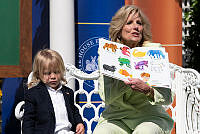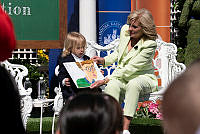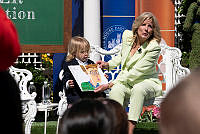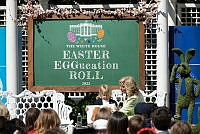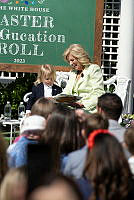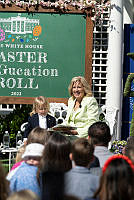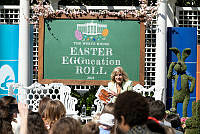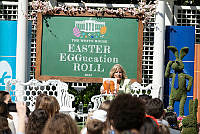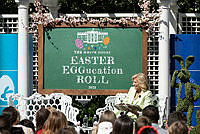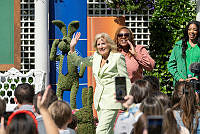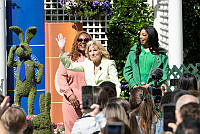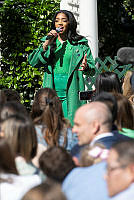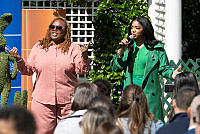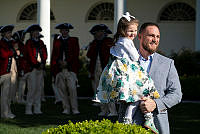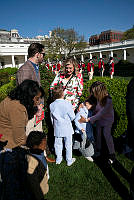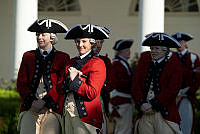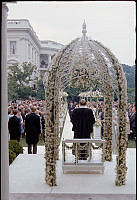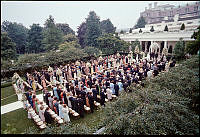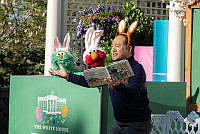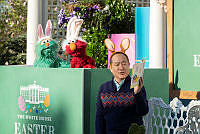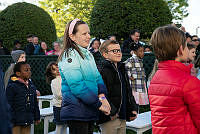Rubenstein Center Scholarship
A History of White House Flowers and Florists

Flowers abound in the White House conservatory, depicted in this illustration as it was in 1858.
White House CollectionApril showers might bring May flowers, but White House florists keep the Executive Mansion in bloom year-round. Today the White House Chief Floral Designer and her staff have a flower shop in the basement of the mansion, beneath the North Portico. They create and maintain arrangements for display in the public and private rooms of the White House and design fabulous centerpieces for events of all kinds. There is hardly a table or mantel that goes unadorned—flowers have become central to the building’s décor.
Yet in the past their presence has not been a priority. In the early 19th century, Americans rarely brought flowers indoors, believing they deprived a room of oxygen and released harmful vapors into the air. Wax flowers took the place of the real thing.1 That belief faded, however, by the 1850s when Harriet Lane—niece and surrogate first lady for President James Buchanan introduced fresh floral arrangements to the White House. Buchanan ordered the construction of a conservatory on the west side of the White House Grounds, giving his niece ready access to choice blooms. Visitors appreciated Lane’s floral flair. The New York Times reported that “bouquets of rare flowers filled the air with perfume” at an 1858 reception. The public also had access to the conservatory, where they could experience the “rare and odorous plants” that flourished under the care of head gardener John Watt.2

Flowers form graceful arcs over the table at an 1871 dinner given by the Grants in the State Dining Room.
White House Collection/White House Historical AssociationHarriet Lane’s successors followed her lead and expanded the use of flowers in the White House. President Ulysses S. Grant and First Lady Julia Dent Grant entertained lavishly, employing impressive floral displays to awe their guests.3 When the Grants’ daughter Nellie was married from the White House in 1874, the mansion overflowed with blooms. In the East Room hung a large marriage bell made of “the choicest white flowers,” according to the Baltimore Sun. Flowered wreaths in the shape of the bride and groom’s initials hung on the walls, and “a bronze cupid… was fairly covered with rare flowers, and the columns were twined with fresh wreaths.” “Never before,” the article proclaimed, “had the East Room presented so brilliant a display of artistic floral adornment.”4
The conservatory continued to supply the White House with fragrant blooms through the end of the 19th century. First Lady Lucy Webb Hayes hired the White House’s first full time floral arrangers, or “bouquet makers,” in the late 1870s.5 The floral arrangers faced their biggest challenge yet when in June 1886 President Grover Cleveland married his young bride, Frances Folsom, in the White House. The mansion’s historic rooms teemed with flowering plants, palms, and ferns. The New York Times described the scene in the Blue Room: “On the hearth under the east mantel lay a mass of begonia rubra, whose scarlet blossoms were designed to represent a glowing fire… Vines ran from the hearth to the mantel, on which reposed a bank of dark pansies with the inscription “June 2, 1886,” in light blossoms.” Red rose garlands hung from the mirrors, and the initials “C. F.” were shaped from roses and white moss.6

Like White House brides before her, Alice Roosevelt, daughter of President Theodore Roosevelt, had lush floral decorations at her 1906 wedding.
Library of CongressThis Gilded Age extravagance, however, did not last. In 1902, President Theodore Roosevelt oversaw a major White House renovation, expanding the White House and restoring its original Federal-period design. The greenhouses were removed to make way for the West Wing offices, and subtle floral arrangements replaced their lavish predecessors, complementing the new décor.7
With the removal of the greenhouses, flowers had to be purchased and delivered to the White House. For the first three decades of the 20th century, expert gardener Charles Henlock (1858-1934) worked at a greenhouse that supplied the White House with its flowers after the 1902 renovation, eventually acquiring the title of Director of Conservatories and Horticulture. Henlock worked closely with first ladies, cultivating flowers according to their personal preferences. On the eve of Herbert Hoover’s inauguration in 1929, Henlock anticipated a meeting with soon-to-be First Lady Lou Hoover. “If she follows the custom,” reported the Washington Post, “she will visit soon after the inauguration and talk with Mr. Henlock about her choice of plants.” If she preferred a color other than pink, the favorite of her predecessor, First Lady Grace Coolidge, Henlock would make the necessary changes.8

The gilded Monroe Plateau, a decorative staple of the State Dining Room, teems with flowers in this 1996 photograph.
White House Historical AssociationMany floral arrangements through the mid-20th century were formal and dome shaped, and favored dense groupings of flowers like carnations and chrysanthemums. In the 1960s, however, First Lady Jacqueline Kennedy facilitated a major transformation, selecting natural bouquets with an airy, informal look. She took a creative approach, using the White House’s antique urns and bowls for vases and selecting local, seasonal flowers. “When the White House crab apple and cherry trees were in bloom,” wrote The New York Times, “Mrs. Kennedy asked that the branches be brought indoors” and incorporated into arrangements.9
First Lady Jacqueline Kennedy also established the Office of the White House Florist, hiring Elmer M. “Rusty” Young as the first Chief Floral Designer. Young and his successors have continued to work with first ladies to design arrangements. For major affairs, florists begin to plan far in advance, taking into account everything from the first lady’s dress to the floral customs of visiting dignitaries. Dottie Temple, Chief Floral Designer during the Nixon, Ford, Carter and Reagan administrations, recalled contacting the State Department prior to state dinners to see what flowers might have different cultural meanings. In Italy, for instance, the chrysanthemum is associated with death, and would make for an awkward centerpiece at an Italian state dinner. Temple also determined if heads of state had any floral preferences. “President Francois Mitterand of France loved roses,” she wrote in her book, “Prime Margaret Thatcher fancied anemones.”10
Dottie Temple’s examples demonstrate the many roles that White House florists play. Their work is at once aesthetic, diplomatic, and historic. Flowers form the background for state dinners, weddings, funerals, and day-to-day operations. Their constant presence is made possible by a hardworking and creative staff that, from their shop on the ground floor, brings color and beauty to the White House every day.

Chief Floral Designer Rusty Young puts the finishing touches on an arrangement in 1966.
White House Historical Association













